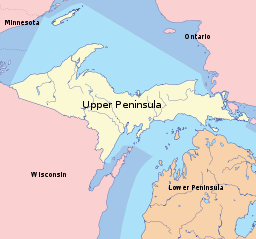Peninsulas of Michigan

The Peninsulas of Michigan are a pair of fresh water peninsulas defined by several components of the Great Lakes and their connecting waterways which together compose the U.S. state of Michigan. The Upper Peninsula to the north has a more rural and jagged landscape than the more urban and level Lower Peninsula to the south. Separating the two parts are the Straits of Mackinac which joins Lake Michigan to Lake Huron at an even flow. Persons crossing between the two landmasses had to use ferries in sometimes ice-prone conditions until the construction of the Mackinac Bridge. Long tracts of shore along both peninsulas with several Great Lakes give Michigan the largest territorial waters of any state except Alaska (which has thousands of miles of coast). The Lower Peninsula has a population that is well over an order of magnitude larger than that of the Upper Peninsula due to the presence of big cities including Detroit and Grand Rapids with histories of substantial manufacturing and technology employment. The cultural differences between the Michigan peninsulas tend to have greater meaning to residents of the Upper Peninsula than to those of the Lower Peninsula due to their reliance on forestry and mining which puts them at variance both economically and politically with the rest of the state.